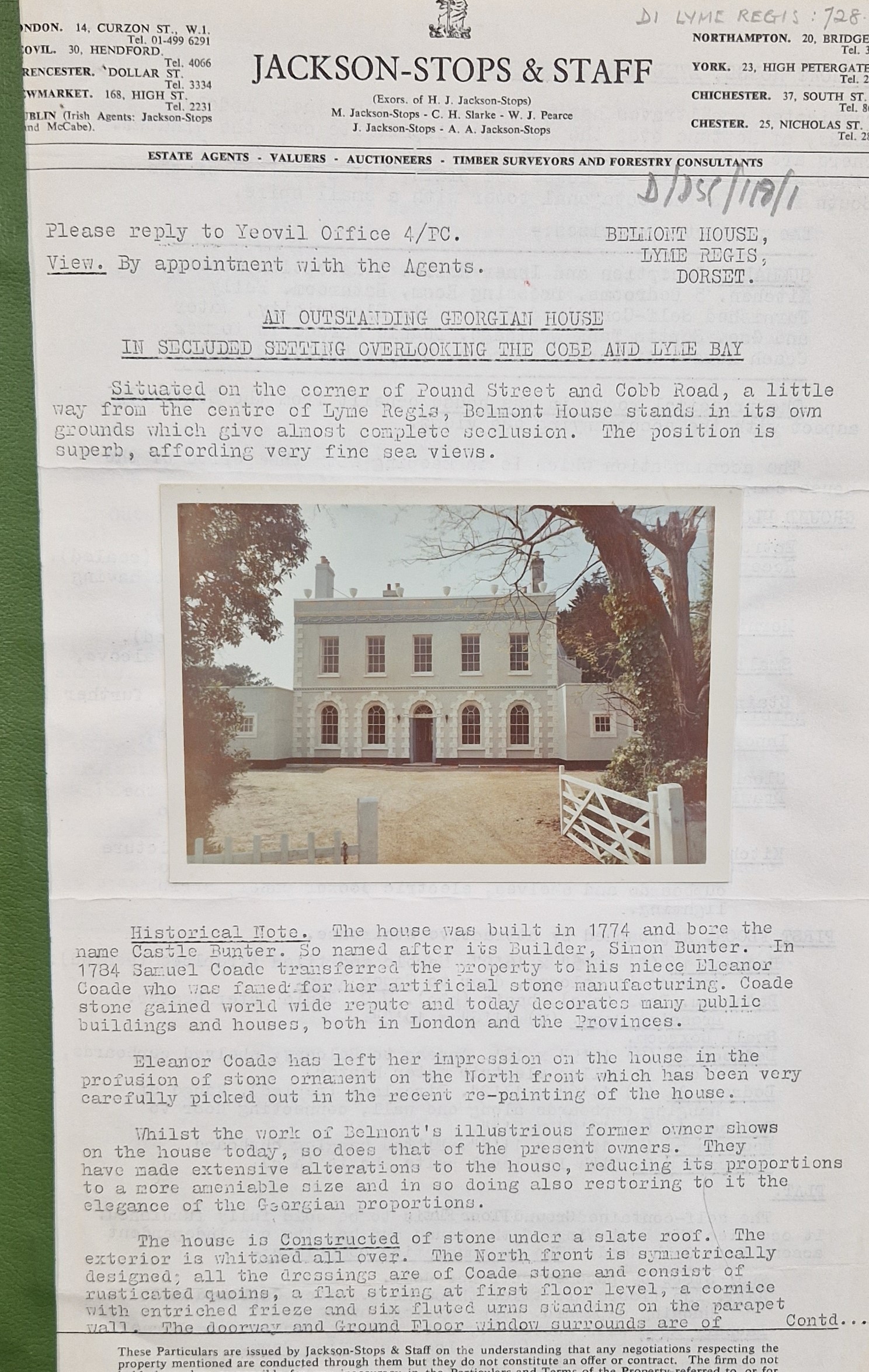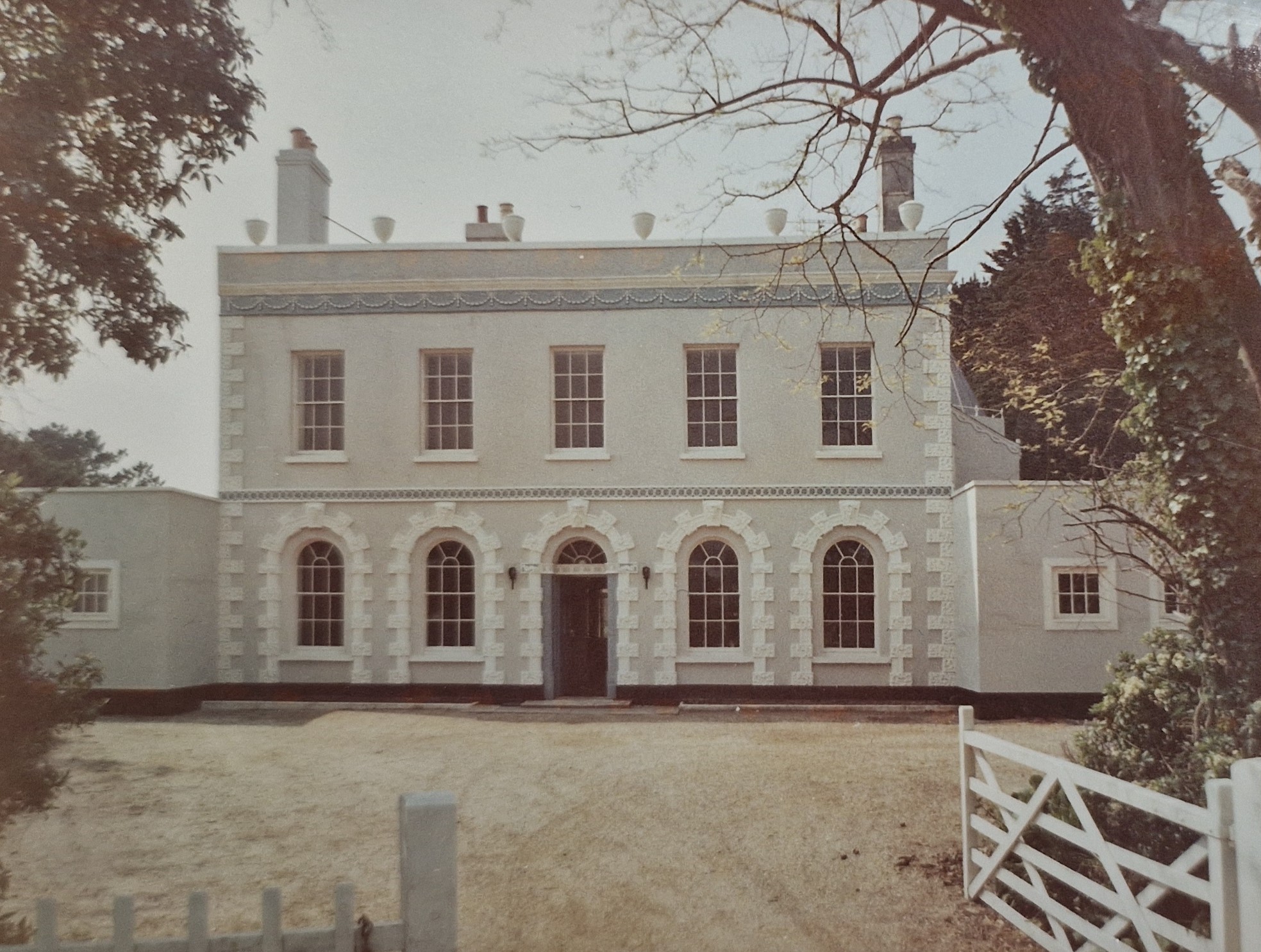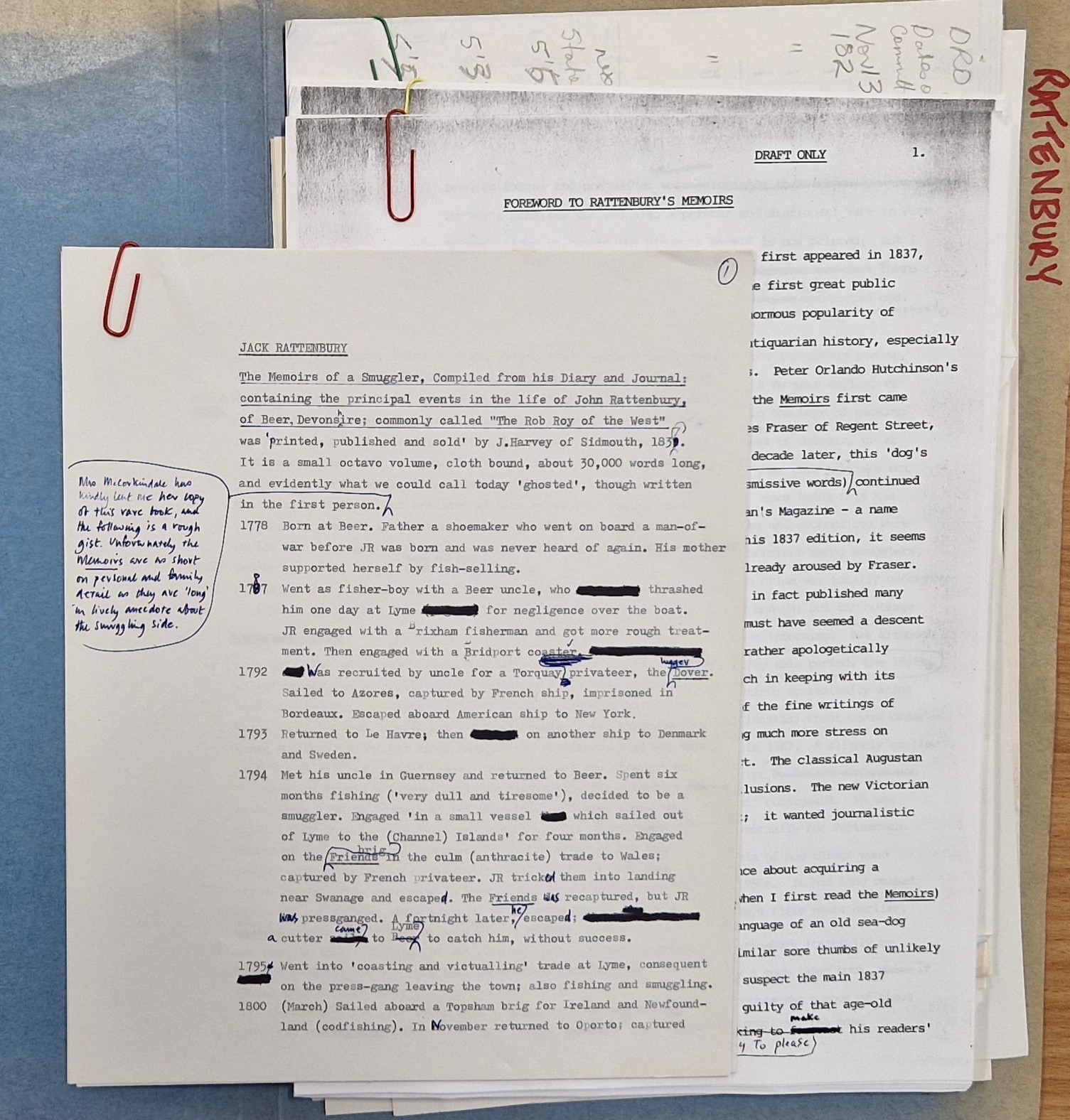In two previous posts, we introduced you to the author John Fowles, and gave you some background on his life, and discussed his interest in Lyme Regis’ own Mary Anning. This time, DHC volunteer Graham takes a deeper look into Fowles’ life and how he settled in Lyme Regis…
—
How He Came to Live in Dorset
In a previous blog, we mentioned that travel had helped to open up new possibilities to Fowles. After Oxford he had spent a couple of terms teaching at the Université de Poitiers, one of the oldest universities in Europe.1 He then interviewed unsuccessfully for translation or teaching jobs in France, England and Scotland. Admitting that he was still looking for something more exotic he considered, through the British Council, possible posts in Brazil, Baghdad or Greece.2 At once choosing the last, he taught for two years at the Anargyrios and Korgialenios School on the Greek island of Spetses, which proved to be the source of many locations in his novel The Magus.
On returning to England in 1953, and job-hunting yet again, he lived in Oxford and London before being offered a job as a tutor at Ashridge College in Hertfordshire. After leaving this post in the autumn of 1954 he was to spend no less than eight and a half years teaching English as a foreign language to girls at St. Godric’s College in Hampstead.3 Only after his first published novel The Collector was clearly going to be a success as both novel and film did he give in his notice. “Proof copies of. It becomes real, reads much better than before. Also the first publicity” he noted in his journal. 4
In 1963 and 1964, now earning as an author and free after years of teaching, he and his wife Elizabeth (they finally married in April 1964) regularly left London to go house-hunting in rural parts of England. In May 1963 he listed what he was looking for: “not less than an acre of ground”, a “house designed for me, or a Georgian one”, “water – the sea or at least a stream”, “an orchard” and “a hilly landscape.”5 With Elizabeth doing all the driving – Fowles never learnt to drive – they visited East Anglia, the Midlands, Somerset, Cornwall, Devon and Dorset.6 In October 1964 they embarked on “Our little tour of the West.”7
During this ten-day trip through Hardy country, and while reading Thomas Hardy’s A Pair of Blue Eyes, he and Elizabeth visited Shaftesbury, East Compton, Dorchester, Abbotsbury, Bridport, Beaminster, Broadwindsor, Whitchurch Canonicorum, Charmouth, Bockhampton, Winfrith Newburgh, Kimmeridge, Corfe Castle, Wyke Regis, Bovington, Buckland Newton, Sturminster Newton and Gillingham, staying one night in Lyme Regis.
“We liked Lyme very much, far and away the best resort on the south coast, with its steep contours, old houses, the sea light, the beautiful harbour – the Cobb, the cliffs.”8
Still looking for his ideal house the following August they visited Lyme Regis again.
“By this time we had abandoned hope of actually seeing a house we would want to buy, but then we arrived at Underhill Farm, near Lyme Regis, down a long unmade road.”9
The house was isolated, old, overpriced and rather neglected; Fowles admitted that it was “ugly, and offends Elizabeth especially… she weeps at night.”10 But they explored the Undercliff, had completed the purchase by the end of September 1965, and moved into Underhill Farm on 19 October.
Fowles regularly mined his boyhood and also places he visited for use in his fiction: Ipplepen in Devon, France, Norway, Spetses. Now it was the turn of Lyme Regis. On 25 January 1967 Fowles began working on The French Lieutenant’s Woman, completing the first draft on 27 October.11, 12
Underhill Farm and Beyond
Underhill Farm was not to be Fowles’ lasting home in Lyme Regis. In early 1968 ten acres of the farm’s fields subsided in a huge landslip.13 This catastrophic event coincided with serious tax and financial difficulties: throughout the 1960s the highest rate of UK income tax had been around 90%. Fowles found the landslide “A kind of release… we’ve got to leave here, and the country”. A week later his reaction remained “one of relief. A feeling that Dorset is a dead end, though one that I am very glad we explored.”14 Like many other British authors at the time he considered becoming a tax exile, perhaps in the Channel Islands, Paris or Malta.
Under pressure to solve his tax problems, and dreaming about the pleasure of new travels abroad, perhaps “six months in Persia, holidays in Japan, Peru, and a dozen other places,”15 John and Elizabeth put Underhill Farm on the market within a week of the landslip. On 24 March 1968 they received an offer, well below what they had spent on the property, but which with the threat of further subsidence they were prepared to accept. Completion was agreed for mid September.
Still working on The French Lieutenant’s Woman, Fowles completed a first revision by the end of April 1968, and two further revisions before the end of August.16 Before then the disadvantages of moving to a tax haven were becoming overwhelming, and in an indecisive way they started looking again at houses in the southwest. They were both finding the imminent move out of Underhill Farm distressing. Elizabeth called it “total madness”17 and Fowles “an amputation.”18

In early July they had looked at Belmont House in Lyme Regis, “the most attractive house in the place, really”, though “the asking price is absurd”.18 They dithered, looking at houses in Corscombe and Morecombelake, and “muttered again about Belmont House.” On 5 September Fowles sent the manuscript of The FLW (as he was now referring to it) to his publisher Tom Maschler. The response came:
“The French Lieutenant’s Woman is magnificent no less. Congratulations”.19
That same day Fowles made an offer for Belmont House, which was to become his home for the rest of his life.20 He soon began looking for historical references to the house, and later this extended to many other Lyme properties.

Here are some of the Lyme properties with files to be found in the Fowles Collection. If you wish to access documents in this Collection please remember that it still awaits sorting, reorganising and cataloguing, so the present listings are only provisional.
| 4a Bridge Street21 | Hallett (Mill Green)21 |
| 6 Bridge Street22 | Lilac Cottage (Church Street)22 |
| 39 Broad Street21 | 4, 5 and 5a Cobb Road21 |
| 53-54 Broad Street/Aveline House21 | 37 Coombe Street21 |
| Rosemount (Charmouth Road)21 | 43-45 Coombe Lane/Street21 |
| Kenmore (Church Street)21 | The Grove21 |
| Clappentail21 | 1 and 2 High Cliff21 |
| 27 Marine Parade21 | Kersbrook21 |
Belmont House and maritime Lyme
On 1 December Fowles was at last able to take possession of Belmont, fetching Elizabeth to join him a week later.23 The main house had been unoccupied for ten years and was not fit to live in. Until May 1969 they survived in a small corner of the ground floor while builders dealt with rotting floors, replaced wiring and central heating and repaired the drains. John and Elizabeth themselves painted and decorated and struggled with the garden (over an acre) which was seriously overgrown.24
Perhaps understandably during 1969 they suffered from episodes of deep depression. They both enjoyed poor health and Fowles had withdrawal symptoms from trying to give up smoking – “absurd quantities of cigarettes… fifty or sixty a day.”25 In the USA the film of his novel The Magus was badly received; even the proposed film of The FLW had so far been turned down by several directors.26
Lyme Regis itself seemed no cure for their mood. Even visits by old friends “irritates us progressively… so we can’t risk having any contact with the Lymers.” As for The FLW
“It’s really all summed up in the total indifference of Lyme itself to the book. Only one person has even mentioned reading it to me; the local paper has passed it by in total silence.”
He continued to express reservations about the local community, but still went on developing his interests in the town itself, its history, its geology and its palaeontology: concerns quite unrelated to London and his literary world.
Lyme’s maritime connections particularly interested Fowles. One complete box in the archive collection is taken up with indexes of seamen, sailors and captains, and an index to vessels registered at the town.27 Another box contains a bound volume of photocopies of a manuscript list of ships, arranged alphabetically.28 Material relating to HMS Formidable, torpedoed on 1 January 1915 and whose survivors were landed at Cobb Gate is to be found in several different boxes.29 There are several Admiralty charts, files relating to ship building at Lyme, Seaton and Beer30, and notes and sketches about the obsolete Chesil Beach lerret.31

Lyme had also been associated with smuggling and the slave trade. One file in the collection deals with ‘Smuggling, notes and correspondence’, another with the famous Jack Rattenbury who published his own autobiography Memoirs of a Smuggler in 1837; a book which Fowles considered “a classic of smuggling literature”.32 Another file deals with a famous privateer, George Somers, born in Lyme Regis in 1554, knighted in 1603, MP for Lyme from 1604, and subsequently the founder of Bermuda; Lyme has a now controversial statue of him.33 There are two files relating to Nigel Tattersfield, to whose book The Forgotten Trade: Accounts of the Slave Trade from the Minor Ports of England Fowles wrote a Forward, including
“I pray people will read this richly detailed and absorbing book, with its vivid renaissance of a matter most of us English seem to have wished into oblivion.”
And then there’s a file of shipwreck photos, presumably in connection with Island Camera: The Isles of Scilly in the Photography of the Gibson Family. And of course several relating to the Cobb, including Fowles’s lecture notes, correspondence and maps34, a copy of Your Walk on the Cobb by palaeontologist Dr Colin Dawes,35 and a sketch plan of an alternative scheme for the Cobb.
—
References:
https://archive-catalogue.dorsetcouncil.gov.uk/records/D-FWL [“D-FWL”]
Charles Drazin (ed.) 2004 John Fowles,The Journals Vol 1 [“Journals 1”]
Charles Drazin (ed.) 2006 John Fowles,The Journals Vol 2 [“Journals 2”]
Eileen Warburton 2004 John Fowles, A Life in Two Worlds [“Warburton”]
1 Warburton p 75
2 Warburton p 87
3 Warburton pp 181-2
4 Journals 1, 20 Nov 1962
5 Journals 1, 11 May 1963
6 Warburton p 274
7 Journals 1, 6-15 Oct 1964
8 Journals 1, 10 Oct 1964
9 https://archive-catalogue.dorsetcouncil.gov.uk/records/D-DPA/1/LR/70
10 Journals 1, 1 Aug 1965
11 Journals 2, 25 Jan 1967
12 Journals 2, 27 Oct 1967
13 Journals 2, 25 Feb 1968
14 Journals 2, 2 Mar 1968
15 Journals 2, 26 Feb 1968
16Journals 2, 25 Aug 1968
17 Warburton p 304
18 Journals 2, 18 Aug 1968
19 Journals 2, 7 Sep 1968
20 https://archive-catalogue.dorsetcouncil.gov.uk/records/D-DSP/118/1
21 D-FWL, Box 8
22 D-FWL, Box 2
23 Journals 2, 8 Dec 1968
24 Warburton pp 307-3083
25 Journals 2, 25 Jun 1969
26 Journals 2, 15 Sep 1969
27 D-FWL, Box 1
28 D-FWL, Box 4
29 D-FWL, Boxes 9 and12
30 D-FWL, Box 12
31 D-FWL, Box 9
32 Fowles 1982 A Short History of Lyme Regis p 38
33 D-FWL, Box 10
34 D-FWL, Box 6
35 D-FWL, Box 5
—
Missed earlier posts in this series? You can read them here:

